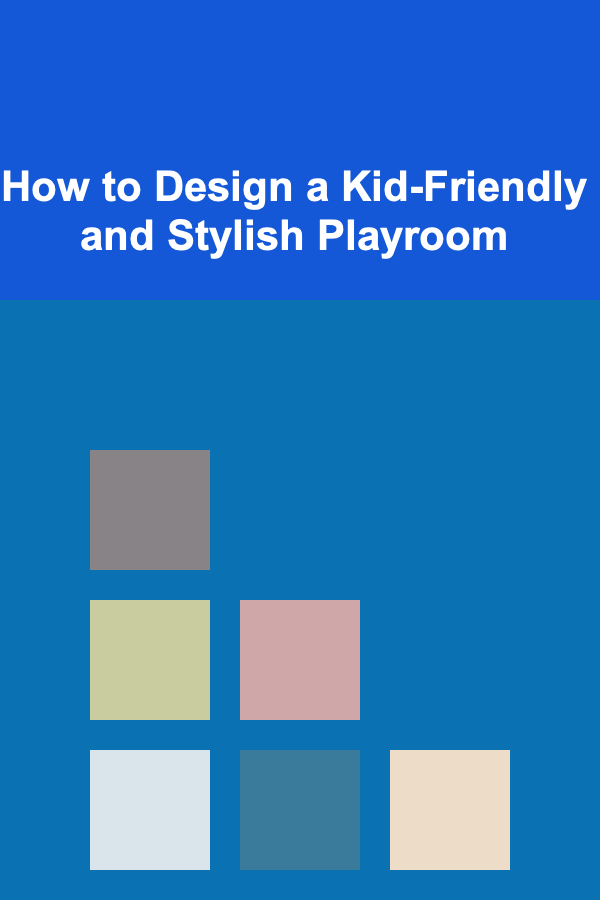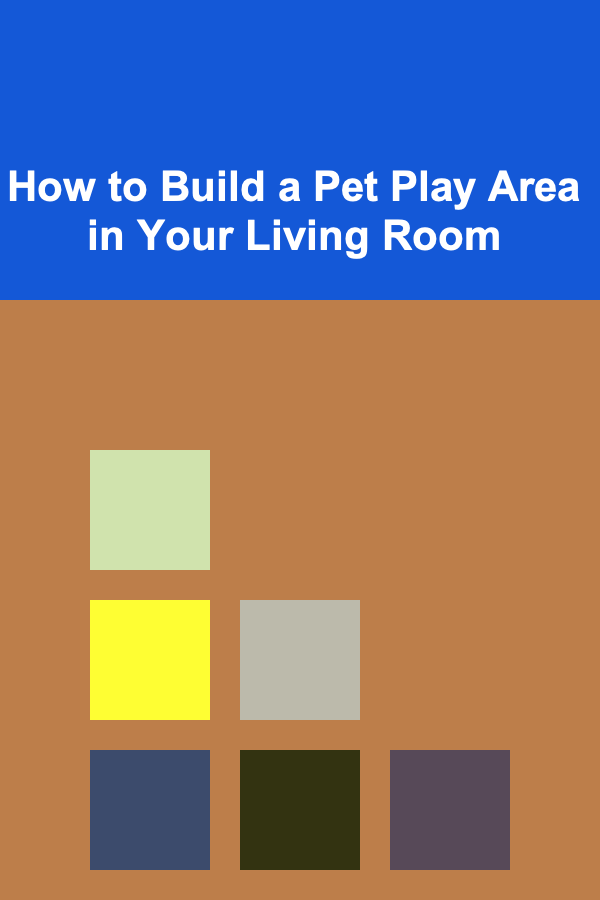
How to Design a Kid-Friendly and Stylish Playroom
ebook include PDF & Audio bundle (Micro Guide)
$12.99$11.99
Limited Time Offer! Order within the next:

Designing a playroom for children can be a fun and rewarding challenge. It's about balancing functionality, safety, and style while creating an environment that encourages creativity, exploration, and learning. Whether you're designing a playroom from scratch or renovating an existing space, it's important to think about how the space can cater to your child's needs while also being aesthetically pleasing.
In this article, we'll explore how to design a kid-friendly and stylish playroom that works for both kids and parents. From choosing the right furniture to incorporating creative design elements, here's how to create a playroom that is not only functional but also fun.
Establish a Theme or Concept
When designing a playroom, the first step is to establish a theme or concept. This will help guide the design process, making it easier to select colors, furniture, and accessories. A theme will give the space a cohesive look and make it feel purposeful rather than chaotic.
Choosing a Theme:
- Nature-Inspired: Opt for natural elements like wood, plants, and earthy tones. This theme can create a calm, grounded environment that promotes imagination.
- Fantasy or Adventure: Think of themes like outer space, underwater worlds, or a jungle adventure. Bold colors, fun graphics, and themed furniture can enhance the playroom's vibe.
- Minimalist: For a more modern approach, a minimalist theme with neutral colors and simple furniture can create a stylish and calm play area.
- Classic or Vintage: A timeless look using vintage toys, old-school furniture, and soft colors can evoke nostalgia while providing a warm and inviting space.
Why It Works:
Having a theme or concept makes decorating much easier. It ensures that the colors, furniture, and accessories are cohesive and allows you to narrow down choices. Additionally, a theme helps foster the child's imagination, turning the space into a world of possibility.
Select Safe, Durable Furniture
Furniture is one of the most important elements of a playroom. Kids are active, and their playtime can be rough on furniture. Therefore, durability and safety should be your top priorities when selecting furniture pieces for the playroom.
Tips for Choosing Furniture:
- Soft Edges: Avoid furniture with sharp corners and edges. Opt for soft, rounded corners on tables, chairs, and shelving units to prevent injury.
- Durable Materials: Look for furniture made from sturdy, easy-to-clean materials. Wood is a great option, but make sure it's finished with non-toxic paint or sealant. Upholstered pieces should have stain-resistant fabrics.
- Multi-Functional Pieces: Consider furniture that can serve multiple purposes. For example, a storage bench doubles as a seat, or an ottoman that can also act as a table.
- Adjustable Furniture: Adjustable tables and chairs allow the furniture to grow with your child, ensuring that it's functional for years to come.
Why It Works:
Durable and safe furniture ensures that the playroom can withstand the wear and tear of daily use. It also reduces the need for constant replacements and repairs, making the space functional in the long term.
Incorporate Plenty of Storage
A well-organized playroom is key to maintaining a stylish and functional space. Kids tend to accumulate a lot of toys, books, and other playtime essentials, so having adequate storage is essential. Without enough storage, the room can quickly become cluttered and chaotic.
Storage Ideas:
- Open Shelving: Open shelves are an excellent way to store toys, books, and games while allowing kids to easily access their favorite items.
- Baskets and Bins: Baskets and storage bins are perfect for keeping small toys, art supplies, and other materials. They come in various sizes and styles, making them easy to incorporate into the design.
- Under-Bed Storage: If you have a large playroom, under-bed storage is a great solution for toys or seasonal items that are not used as often.
- Toy Storage Furniture: Invest in furniture pieces designed specifically for toy storage, such as toy chests or multi-drawer units.
Why It Works:
By having plenty of storage options, you can keep the space organized and avoid clutter. An organized space not only looks better but also makes it easier for children to clean up and take care of their belongings.
Create Zones for Different Activities
Designing a playroom that caters to different types of play and learning will keep the space engaging and versatile. It's important to create different areas or zones within the room for various activities, like reading, art, and imaginative play.
Ways to Create Activity Zones:
- Reading Nook: Set up a cozy reading area with soft rugs, comfortable pillows, and shelves filled with books. Adding a small table for writing or drawing can encourage children to enjoy quiet time.
- Art Station: A table with art supplies, such as crayons, markers, paper, and paint, will allow children to express their creativity. A chalkboard wall or a large roll of paper can provide an additional surface for artistic exploration.
- Building or Play Area: If your child enjoys building things, set up a designated area with building blocks or a small toy kitchen. Soft rugs and foam tiles can create a comfortable and safe play area.
- Play Tent or Fort: Adding a play tent or small fort can create a private space for imaginative play, offering children a personal area to relax or create their own little world.
Why It Works:
Creating designated activity zones helps organize the space and allows children to engage in different types of play without the room feeling overwhelming. It also gives the room a sense of purpose, making it a more functional environment for both kids and parents.
Choose Kid-Friendly Colors and Patterns
The colors you choose for the playroom can have a huge impact on the mood and energy of the space. Bright, vibrant colors can stimulate creativity and energy, while soft pastels or neutrals can create a calming atmosphere. The key is to select colors that reflect the playful nature of the room while also complementing the overall design.
Tips for Color and Pattern:
- Bright and Bold: Primary colors like red, yellow, and blue are timeless choices for playrooms. They can be incorporated into furniture, walls, or accessories.
- Pastels: Soft pastels like mint green, blush pink, and light blue can give the room a more serene vibe, especially when paired with neutral tones like white or gray.
- Neutral Backdrops: For a modern look, you can use neutral colors on the walls and add pops of color through furniture, rugs, and wall art.
- Fun Patterns: Playful patterns like stripes, polka dots, and geometric shapes can add a fun touch to the room. Incorporate them into rugs, throw pillows, curtains, or wall decals.
Why It Works:
Kid-friendly colors and patterns create an energetic, fun environment that encourages children to play and explore. Color also plays a role in shaping a child's mood, so it's important to find a balance between energizing colors and calming hues.
Incorporate Personalization
Personalization adds a special touch to the playroom, making it feel like the child's own space. Allowing children to choose certain aspects of the design or incorporating their interests can make the room more meaningful to them.
Ways to Personalize:
- Wall Art: Hang framed art prints, family photos, or children's artwork to give the room a personal touch.
- Name or Initial Wall Decals: Adding a child's name or initials in a fun font can make the room feel more personalized.
- Custom Furniture or Accessories: Consider having custom furniture made, such as a personalized chair or a toy chest with the child's name on it.
Why It Works:
Personalized elements create a sense of ownership and pride, helping children connect with their playroom. It also adds a unique and meaningful aspect to the design, making it more than just a functional space.
Keep Safety in Mind
Safety is paramount when designing a playroom. Children are naturally curious and often explore by touching, climbing, or knocking things over, so it's crucial to make the room as safe as possible.
Safety Tips:
- Non-Toxic Materials: Ensure that all paints, finishes, and fabrics used in the room are non-toxic and child-friendly.
- Anchor Heavy Furniture: Anchor bookshelves and other heavy furniture pieces to the wall to prevent them from tipping over.
- Flooring: Soft flooring options, like foam tiles or rugs, are ideal for cushioning falls and protecting children from injury.
- Electrical Safety: Keep electrical outlets covered and avoid using cords that could pose a tripping hazard.
Why It Works:
A safe playroom allows children to explore freely without the constant worry of accidents. By taking the necessary precautions, you can create a space that both kids and parents can enjoy with peace of mind.
Conclusion
Designing a kid-friendly and stylish playroom is a balancing act between safety, functionality, and creativity. By choosing durable furniture, creating activity zones, selecting vibrant colors, and personalizing the space, you can create a room that fosters imagination, learning, and fun. A well-designed playroom will not only be a place where children can enjoy hours of play but also a stylish and welcoming space for the whole family to enjoy.
Reading More From Our Other Websites
- [Beachcombing Tip 101] Best Sustainable Packing List for Multi‑Day Beachcombing Trips in Remote Archipelagos
- [Home Budget 101] How to Create a Debt-Free Home Budget
- [Home Soundproofing 101] How to Use Foam Insulation to Soundproof Your Home
- [Personal Investment 101] How to Invest in Precious Metals as a Hedge Against Inflation
- [Beachcombing Tip 101] Marine Marvels: Rare Creatures and Materials That Make the Sea a Treasure Trove
- [Personal Care Tips 101] How to Choose a Deodorant That Is Travel-Friendly and Compact
- [Personal Care Tips 101] How to Choose Acne Treatment Creams That Won't Interfere with Makeup
- [Home Holiday Decoration 101] How to Master the Art of Holiday Decorating with Cinnamon Sticks: A Complete Guide
- [Home Space Saving 101] How to Organize Small Living Spaces for Maximum Functionality
- [Home Staging 101] How to Choose a Home Stager That Specializes in Luxury Properties: A Guide

How to Build a Pet Play Area in Your Living Room
Read More
How to Create a Productive Study Space for Kids
Read More
How to Use Lighting to Make Your Entryway More Inviting
Read More
How To Use Inkscape for Free Vector Graphics
Read More
How to Master Backcountry Cooking Techniques
Read More
10 Tips for Achieving Consistent Glass Color in Your Blown Pieces
Read MoreOther Products

How to Build a Pet Play Area in Your Living Room
Read More
How to Create a Productive Study Space for Kids
Read More
How to Use Lighting to Make Your Entryway More Inviting
Read More
How To Use Inkscape for Free Vector Graphics
Read More
How to Master Backcountry Cooking Techniques
Read More